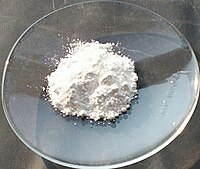
Photo from wikipedia
Abstract In the present study, we have investigated the structural, energetic, electronic and magnetic properties of zinc blende cadmium chalcogenides CdCh (Ch = S, Se and Te) compounds doped with… Click to show full abstract
Abstract In the present study, we have investigated the structural, energetic, electronic and magnetic properties of zinc blende cadmium chalcogenides CdCh (Ch = S, Se and Te) compounds doped with group 14 elements, M = C, Si and Ge, at the anion site, using spin-polarized density functional theory calculations. The stability of all the M-doped CdCh systems is examined by computing formation energy at selected values of the chemical potentials for the atomic species participating in substitutional doping. In addition, the thermal stability of pristine as well as doped systems is examined by employing ab-initio molecular dynamics simulations. The effect of structural relaxation on the bond lengths together with the magnetic moments of M-doped CdCh systems indicate that the difference in the electronegativities and atomic radii of the dopant and chalcogen atoms determines the magnetic behaviour in these materials. Our results reveal that the spin-polarized electronic properties in M-doped cadmium chalcogenides are mainly caused by the occupancy of p orbitals of the dopant tetrels. Asymmetric insulating and p-type nature in spin-up and spin-down channels, respectively, is obtained in all M-doped CdS and CdSe compounds and Ge-doped CdTe, which results in a total magnetic moment of 2.0 μB per supercell. The magnetic moments of silicon and carbon doped CdTe, on the other hand, are found to be 1.88 μB and 0.07 μB, respectively, where the vanishing magnetic moments is caused by decreasing assymteric distribution of electrons in the spin-up and spin-down states of Si-3p and C-2p states.
Journal Title: Materials today communications
Year Published: 2020
Link to full text (if available)
Share on Social Media: Sign Up to like & get
recommendations!